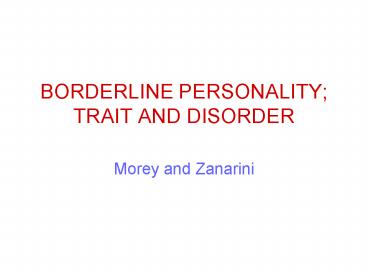BORDERLINE PERSONALITY; TRAIT AND DISORDER - PowerPoint PPT Presentation
1 / 12
Title: BORDERLINE PERSONALITY; TRAIT AND DISORDER
1
BORDERLINE PERSONALITY TRAIT AND DISORDER
- Morey and Zanarini
2
BPD?
- Distinct personality disorder beginning in
childhood and characterised by pervasive pattern
of impulsivity and unstable personal
relationships, self-image and affect. - Includes
- frantic attempts to avoid real or imagined
abandonment - intense and unstable personal relationships
- fluctuating self image
- impulsivity and recurrent suicidal or self
mutilating gestures or behaviour - emotional instability
- transient stressrelated paranoia or dissociation
- Clinical diagnosis must meet minimum of five of
the DSM-IV criteria
3
TWO REPRESENTATIONS BPFFM and Categorical
Diagnosis
- Global level BPM characterized by very high N,
low A and low C, explaining features such as
identity problems and fears of abandonment - BUT other features not associated with FFM
4
PRESENT STUDY
- Goal One
- Relationship FFM in a clinical sample
- Goal Two
- Highlight aspects of categorical diagnostic
concept not captured by the FFM representation - Does FFM miss essential aspects of the BP
diagnosis? - Do the residual elements of the categorical
diagnosis add to a diagnostic understanding of
BP?
5
CONTRIBUTION OF RESIDUAL TO DIAGNOSTIC VALIDITY
- Antecedent validity etiological factors (family
history of psychiatric disorders, childhood abuse
and neglect) - Concurrent validity symptoms of dysphoric inner
states and dissociative experiences - Predictive validity intermediate term outcomes
at two follow-up intervals temporal patterns of
functional behaviour.
6
Method
- Participants
- Inpatients at a hospital in Massachusetts
- Aged 18-35
- Normal or better intelligence
- No history or current symptoms of serious organic
condition - Had been assigned a definite or probable Axis II
diagnosis by a physician - This resulted in 378 subjects available for
testing
7
Instruments
- 3 semi-structured interviews
- Structured Clinical Interview for DSM-III-R Axis
I Disorders - Revised Diagnostic Interview for Borderlines
(DIB-R) - Diagnostic Interview for DSM-III-R Personality
Disorders (DIPD-R) - Five Factor Model
- Self-reported version of the NEO Five-Factor
Inventory - Difficult Childhood Experiences
- Revised Childhood Experiences Questionnaire,
which is a semi-structured interview
8
Family History
- Revised Family History Questionniare
- Symptomatology Associated with BPD
- Dissociative Experiences Scale and the Dysphoric
Affect Scale - Global Outcome At Follow-up (2 and 4 years)
- The Global Assessment of functioning scale
- Psychosocial functioning assessed with the
Revised Borderline Follow-up Interview
9
Results
- Participants 290 BPD, 72 at least one other Axis
2 disorder (control).
Nonborderline Nonborderline Borderline Borderline
Trait Mean SD Mean SD Sig
N 26.33 7.9 35.07 7.0 plt.001
E 25.66 6.7 22.59 6.9 plt.001
O 30.51 6.6 29.80 6.6 ns
A 32.68 6.5 30.35 6.7 plt.01
C 28.59 7.4 28.56 7.7 ns
10
Regression analysis
- N seemed to be the largest differentiation
between borderline and non-borderline patients. - C was the only other sig. factor but suggests
that it is a suppressor, in that high levels of C
removes an unwanted portion of the variance in
the N variable. - FFM captures a sizable proportion of the variance
associated with a borderline diagnosis. - But what about the rest of the diagnostic
variance?
11
More than personality?
- There were aspects within the 4 sections of the
DIB-R that werent fully captured by the NEO-FFI.
Impulse action patterns were the least
represented. - But correlation with measures of BPD showed that
the NEO-FFI representation explained a sig.
proportion of the historical and outcome
variables. - But also history of sexual abuse was related to
BPD diagnosis in a way not fully captured by the
NEO-FFI. - FFM factors were more highly associated with long
term outcome than elements of BPD that were
independent of these factors.
12
IN CONCLUSION
- Diagnosis BP related to FFM
- N scores elevated compared other patients PDs.
- C discriminated BPD from other PDs but limited
effect. - FFM did NOT capture all definitional aspects of
BPD - DBI-R four section all included aspects not
represented by FFM. Affect section best explained
(N) but impulsive actions least explained. - 3. Diagnostic elements independent FFM are
valid elements of the disorder and are associated
with theoretically important correlates
(antecedent, concurrent and predictive) of the
disorder not error variance. - N as a characteristic level of personality
dysfunction... is almost ubiquitous within
clinical populations - BUT
- Residual elements represent theoretically viable
aspects of BPD - DISTINCTION DISORDER (BPD) AND TRAIT (N)
- BPD disorder that changes in severity over time
whereas N reflects a stable trait. - N represents estimate of LT outcome
- Disorder representing meaningful predictors
within certain sectors in response to the
situation e.g. symptom severity.

